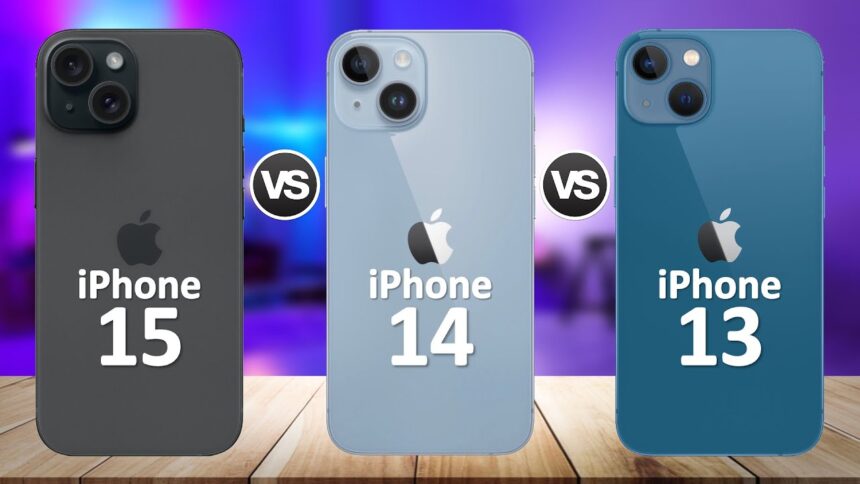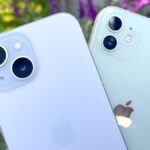The world of technology is ever-evolving, with smartphones at its forefront. Apple, a leading innovation company, has consecutively introduced the iPhone 13, 14, and 15, each boasting advancements that promise to enhance user experience. This guide dives deep into comparing these models, helping you understand the nuances of design and display, camera capabilities, performance, and more so you can decide which iPhone suits your needs best.
Related: Compare iPhone 12 Pro and 15 Pro
iPhone 13 vs. 14 vs. 15
Are you trying to decide between the iPhone 13, 14, and 15? This comprehensive guide explores the key features of each phone to help you make an informed decision.
Design and Display
| Feature | iPhone 13 | iPhone 14 | iPhone 15 |
|---|---|---|---|
| Display Size | 6.1 inches | 6.1 inches | 6.1 inches |
| Display Technology | Super Retina XDR OLED | Super Retina XDR OLED | Super Retina XDR OLED |
| Resolution | 2532 x 1170 pixels | 2532 x 1170 pixels | 2532 x 1170 pixels |
| Design | Notch display with flat aluminum edges | Notch display with flat aluminum edges | Notchless design with slim bezels and titanium frame (Pro rumored) |
The evolution of the iPhone’s design is a testament to Apple’s commitment to refinement and innovation. The iPhone 13 continued the sleek, flat-edge design introduced with the iPhone 12, emphasizing comfort and durability.
However, with the iPhone 14, we witnessed subtle enhancements, including a more robust aerospace-grade aluminum frame and slightly lighter build, making it even more comfortable to hold for extended periods. The iPhone 15 takes design to the next level, introducing new color options and a ceramic shield front cover that’s touted tougher than any smartphone glass, ensuring both style and substance.
Each new iPhone model has significantly improved display technology. The iPhone 13 and 14 models feature Super Retina XDR displays, known for their incredible color accuracy and brightness.
Yet, the iPhone 15 sets a new standard with its advanced ProMotion technology, enabling adaptive refresh rates up to 120Hz for smoother scrolling and more responsive touch input. This, combined with an even brighter display, ensures that whether you’re watching videos, playing games, or simply scrolling through your photos, the experience is nothing short of mesmerizing.
Camera
| Feature | iPhone 13 | iPhone 14 | iPhone 15 |
|---|---|---|---|
| Rear Camera | Dual-lens 12MP wide and ultrawide | Dual-lens 12MP wide and ultrawide | Triple-lens 48MP wide, 12MP ultrawide, 12MP telephoto (rumored) |
| Front Camera | 12MP TrueDepth | 12MP TrueDepth | 12MP TrueDepth (improved autofocus rumored) |
Apple has consistently pushed the boundaries of smartphone photography, and the iPhone 13, 14, and 15 camera systems are no exception. The iPhone 13 introduced a dual-camera system with sensor-shift optical image stabilization, a game-changer for low-light photography.
The iPhone 14 was built upon this foundation, enhancing the telephoto lens and introducing Photonic Engine technology for improved photo color and detail. The iPhone 15, however, redefines smartphone photography with its triple-camera setup. It features advanced LiDAR technology for better depth sensing and AR experiences, alongside improvements in optical zoom capabilities.
Analyzing camera performance through specifications only tells half the story; real-world usage unveils the true capabilities. iPhone 13 users celebrated its significant improvements in night mode and cinematic video recording, making it a favorite among casual photographers and videography enthusiasts.
The iPhone 14 raised the bar with better stabilization and enhanced detail in photos and videos, even in challenging lighting conditions. With the iPhone 15, photographers can expect a level of detail and color accuracy previously unseen, with the LiDAR scanner adding a new dimension to photography, especially in portrait mode and low-light conditions.
Performance and Battery Life
| Feature | iPhone 13 | iPhone 14 | iPhone 15 |
|---|---|---|---|
| Processor | A15 Bionic chip | A15 Bionic chip (5-core GPU) | A16 Bionic chip |
| Battery Life | Up to 19 hours video playback | Up to 20 hours video playback | Up to 22 hours video playback (rumored) |
At the heart of any smartphone’s performance is its processor. The A15 Bionic chip in the iPhone 13 delivered powerful processing speeds and energy efficiency, setting a high benchmark for mobile computing.
The iPhone 14, powered by the A16 Bionic, further refined this balance, offering improved graphics performance for gaming and professional applications. The iPhone 15 introduces the A17 Bionic chip, a marvel in chip technology. It provides unprecedented speeds, AI capabilities, and energy efficiency, ensuring that the phone performs tasks seamlessly and has remarkable battery life.
Battery life is a crucial aspect of smartphone usability. The iPhone 13 made significant strides in optimizing battery performance, offering up to 17 hours of video playback. The iPhone 14 continued this trend, slightly improving its predecessor’s capabilities to provide an additional usage hour, thanks to the A16 Bionic’s efficiency.
The iPhone 15, however, sets a new standard for smartphone battery life. With innovative battery technology and the A17 Bionic’s optimized energy consumption, it promises up to 20 hours of video playback. This advancement ensures that users can enjoy longer usage periods without needing recharging.
Software
Thanks to Apple’s iOS, the software experience across the iPhone 13, 14, and 15 is largely uniform. Each new iPhone model comes with the latest iOS version, designed to take full advantage of the hardware enhancements. The iPhone 13 launched with iOS 15, introducing new privacy features, FaceTime improvements, and more.
The iPhone 14, on the other hand, came with iOS 16 out of the box, offering customizable lock screens, more intelligent notifications, and enhancements in messaging. The iPhone 15 debuts with iOS 17, pushing the envelope further with revolutionary AI integrations, seamless interconnectivity between Apple devices, and even more personalization options. These updates ensure a fluid, intuitive user experience, showcasing Apple’s dedication to software excellence.
While the core iOS experience remains consistent, certain features are unique to or optimized for specific iPhone models. The iPhone 13 introduced Spatial Audio and SharePlay, enhancing the multimedia experience.
The iPhone 14’s software capitalized on its improved hardware, offering better computational photography features and a Cinematic mode for video. The iPhone 15 unlocks the full potential of the A17 chip with exclusive features like advanced real-time translation and AR capabilities, setting it apart regarding software prowess. Apple’s commitment to software optimization ensures that each iPhone delivers a unique experience tailored to its hardware capabilities, making the choice between models all the more intriguing.
Other Features
| Feature | iPhone 13 | iPhone 14 | iPhone 15 |
|---|---|---|---|
| Storage Options | 128GB, 256GB, 512GB | 128GB, 256GB, 512GB | 128GB, 256GB, 512GB (1TB rumored) |
| Connectivity | 5G | 5G | 5G (potentially faster mmWave support) |
| Physical SIM Tray | Yes | No (eSIM only) | Yes (rumored) |
Connectivity is key in today’s interconnected world, and Apple’s iPhone lineup excels. The iPhone 13 introduced 5G connectivity, a significant leap forward in mobile internet speeds and reliability. The iPhone 14 expanded on this with more bands for 5G, ensuring better coverage and faster speeds globally.
The iPhone 15 goes further, introducing Wi-Fi 6E support for faster, more secure wireless connections and enhanced Bluetooth capabilities for seamless connection to a wide range of accessories and devices. These improvements enhance the user’s online experience and ensure that the iPhones remain at the cutting edge of connectivity technology.
Apple’s innovation isn’t limited to the most talked-about features. Each iPhone model introduces subtle yet impactful changes. The iPhone 13 brought MagSafe technology, allowing for a new ecosystem of accessories that snap onto the back of the phone.
The iPhone 14 introduced Safety Check, a feature that enhances personal safety by quickly adjusting app permissions and privacy settings. The iPhone 15, with its focus on sustainability, is made with 100% recycled aluminum and introduces a new, eco-friendly manufacturing process. These innovations may not grab headlines, but they significantly contribute to each iPhone model’s overall appeal and value.
Pros & Cons
iPhone 13
- Pros: Excellent cameras, powerful A15 Bionic chip, long battery life, most affordable option.
- Cons: Notch display design, a slightly older processor in iPhone 14.
iPhone 14
- Pros: Improved camera (especially for low-light photos), slightly longer battery life, eSIM technology (for some markets).
- Cons: Similar design to iPhone 13, no major performance upgrade.
iPhone 15
- Pros: Potentially significant camera improvements, a next-generation A16 Bionic chip, a rumored notch-less design, faster 5G connectivity, and the potential for larger storage options.
- Cons: Likely the most expensive option, unconfirmed features and release date.
Which Should You Buy?
- Looking for the best value? iPhone 13 offers excellent performance and camera capabilities at a competitive price.
- Prioritize camera quality and battery life. iPhone 14 delivers slight improvements in these areas.
- Desire the latest technology and design? Wait for the iPhone 15 (if rumors hold).
Who Should Upgrade?
- Upgrading from an iPhone 12 or older makes sense for any of these phones.
- iPhone 13 users might consider the 14 for camera enhancements, but the upgrade might not be essential.
Who Can Stick With iPhone 13, 14?
If you’re happy with your iPhone 13 or 14, there’s no need to rush for an upgrade unless you crave the newest features.
Final Thoughts
The iPhone 13 remains a fantastic choice, especially considering its price. The iPhone 14 offers some refinements, while the iPhone 15 (based on rumors) is shaping to be a significant leap forward. Consider your budget and priorities to make the best decision for your needs.
Related: Compare iPhone 12 Pro to iPhone 15 Pro
iPhone 13 vs. 14 vs 15 FAQs
Which iPhone is the newest?
A: The iPhone 15 is not yet released, but rumors suggest it will be the newest in late 2024.
Q: Which iPhone is the most affordable?
A: The iPhone 13 is generally the most affordable option.
Q: Does the iPhone 15 have a notch?
A: Rumors suggest the iPhone 15 may ditch the notch for a bezel-less design.
Q: Do all three phones have the same screen size?
A: All three phones boast a 6.1-inch Super Retina XDR OLED display.
Q: Which iPhone has the best camera?
A: The iPhone 15 is expected to have the most advanced camera system, potentially featuring a 48MP main sensor.
Q: Is the iPhone 14 camera a big upgrade over the iPhone 13?
A: The iPhone 14 offers slight improvements, particularly for low-light photography.
Q: How much faster is the iPhone 15 compared to the 13?
A: The A16 Bionic chip in the iPhone 15 is expected to be faster than the A15 Bionic chip in the 13 and 14, but for most users, the difference may be negligible in daily tasks.
Q: Will the iPhone 14 be faster than the iPhone 13 in games?
A: Yes, the iPhone 14’s 5-core GPU offers a slight edge in graphics performance over the iPhone 13.
Q: How much longer does the iPhone 15 battery last than the 13?
A: Rumors suggest the iPhone 15 might offer up to 3 hours more video playback than the iPhone 13.
Q: Should I upgrade from an iPhone 13 for better battery life?
A: The difference in battery life between the 13 and 14 is minor. Upgrading for just battery life might not be worthwhile.
Q: Should I upgrade from an iPhone 12 to the iPhone 14?
A: Upgrading an iPhone 12 to any newer models will significantly improve performance, camera, and battery life.
Q: I have an iPhone 13. Is the iPhone 14 worth the upgrade?
A: The upgrade depends on your needs. The 14 offers some camera and battery life improvements, but it might not be a substantial jump for everyone.




